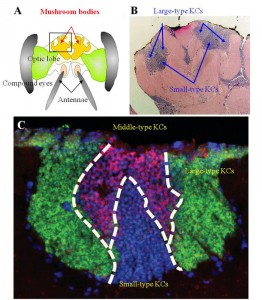Discovery of novel honeybee brain neurons active during foraging flight ‘Middle-type Kenyon cells’ with unique gene expression profile


© Kumi Kaneko and Takeo Kubo.
Three types of Kenyon cells (KCs) that are present inside of the calyces of the honeybee mushroom bodies.
(A) Schematic drawing of the honeybee brain, (B) Large-type and small-type KCs observed in the mushroom body section (conventional undestanding), (C) Three types of KCs discriminated based on gene expression profiles. Green: Large-type KC-preferential CaMKII expression. Magenta:‘Middle-type KC’ preferential mKast expression, Blue: Nuclear staining of small-type KCs.
European honeybee workers returning from a foraging flight inform their nestmates of the direction and distance of food sources through dance communication. Identification of brain neurons active during the dance or foraging flight and analysis of their cell features (development, projection and gene expression) are important for understanding the neural basis of this behavior.
It had been conjectured that the mushroom bodies, a paired structure of the honeybee brain responsible for higher brain functions, were involved in this communicative ability, but it was not clear how. Additionally, two types of intrinsic neurons, termed large-type and small-type Kenyon cells (KCs) have been found inside the calyces (cups) of the mushroom bodies.
In the present study, Dr. Kumi Kaneko, Prof. Takeo Kubo and their colleagues in the Department of Biological Sciences in the University of Tokyo’s Graduate School of Science used gene expression analysis of a novel gene, termed mKast;, in the honeybee brain and identified a novel type of KC. The newly-identified KCs have somata located at the interface of the large-type and small-type KCs and preferentially express mKast, so the researchers termed them ‘middle-type KCs’. Furthermore, the researchers demonstrated, for the first time, that both small-type KCs and some of the middle-type KCs are active in the brains of foraging honeybee workers. Future analysis of the functions of small-type and middle-type KCs and mKast will contribute to our understanding of the neural basis underlying honeybee dance communication.
Press release (Japanese)
Paper
Kumi Kaneko, Tsubomi Ikeda*, Mirai Nagai, Sayaka Hori, Chie Umatani, Hiroto Tadano, Atsushi Ugajin, Takayoshi Nakakoka, Rajib Kumar Paul, Tomoko Fujiyuki, Kenichi Shirai, Takekazu Kunieda, Hideaki Takeuchi, Takeo Kubo,
“Novel Middle-Type Kenyon Cells in the Honeybee Brain Revealed by Area-Preferential Gene Expression Analysis”,
PLOS ONE 2013/8/22 (Japan time), doi: 10.1371/journal.pone.0071732.
Article link
Links
Department of Biological Sciences, Graduate School of Science
Laboratory of Physiological Chemistry, Department of Biological Sciences, Graduate School of Science







